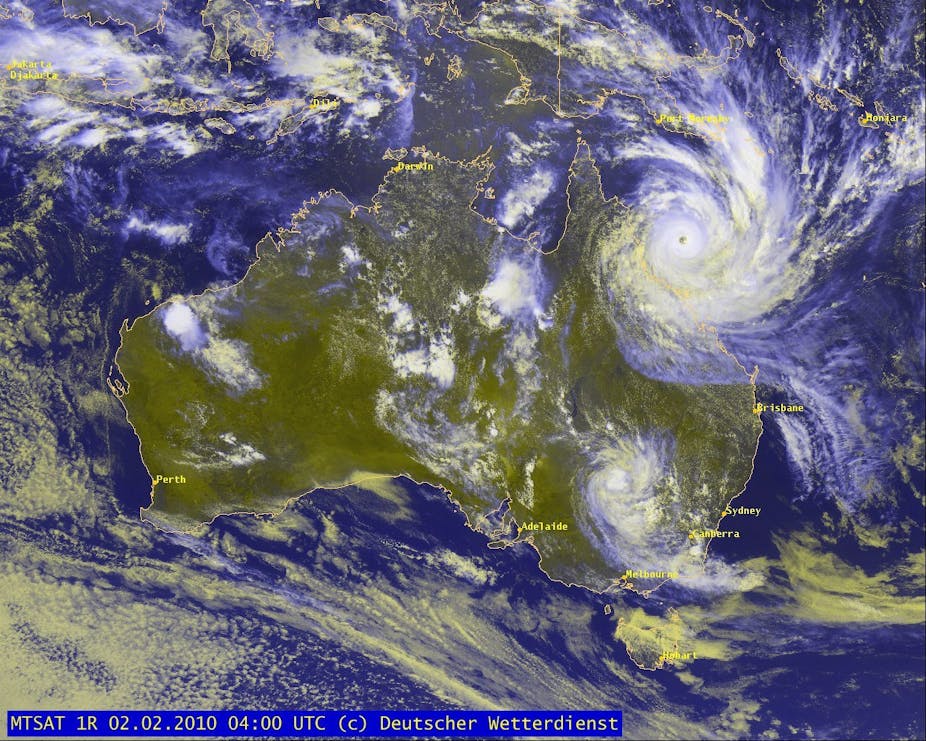Australia’s Chief Scientist Ian Chubb has more than once described the Australia of the past as a “mendicant country” regarding science.
While this is a controversial, perhaps overly-broad, generalisation, that description is unsettlingly apt when it comes to our access to space-based technologies.
Australia owns very little of the space infrastructure it routinely needs to use, and our own Earth satellites are limited to a handful sent up by others for commercial communications.
So Australia has a few “second tier” space assets, which are lower cost, and which typically focus on specific countries or regions, and travel in an equatorial plane. They tend to be task, or purpose, specific.
What we don’t own is “first tier” space assets – satellites that maintain polar orbits, that over time can track view the entire globe and can be generically purposed for all kinds of activities.
This kind of kit allows things such as broader communication capacity and the images you see on Google Earth. This is the type of data we must purchase from other countries.

So what does our mediated access mean in practice? Well, during the Black Saturday bushfires in Victoria for example, the movement of bushfires was tracked using data from China’s National Space Administration, and all our weather satellite data comes from Japan.
Risky …
And even assuming we maintain at least cordial, if not friendly, relations with the countries from whom we buy or borrow satellite capacity, there are still problems.
In requesting another power to fly over areas of our country to provide us with information about our own crops (which we do), we are giving away a wealth of intelligence to potential competitors on commodity markets. Revealing our hand becomes even more precarious when we are gathering intelligence data using someone else’s toys.
Our highly-exposed position in regards to our Earth observation capacity is neatly summarised in this 2010 report:
“ … million-dollar Australian government programmes and executing agencies are completely dependent on the health and continuity of the foreign-owned and operated space assets, which provide necessary imaging, positioning and data relay services …
"This data flow is essential for Australia and we access these data by the good graces of our bilateral agreements or through commercial arrangements. We have no independent autonomy in this regard and are therefore highly exposed and potentially vulnerable to changing international arrangements.”

So it’s not at all surprising strong arguments have been made that Australia at least needs to develop and launch its own Earth Observation satellites given we rely so much on the data these provide, and on the countries who provide us access to theirs.
But this isn’t necessarily a bad thing.
Australia’s strongest capability is in the integration and analysus of Earth Observation (EO) and Geographic information system (GIS) data and in 2008, EO was the number one spend by government. Also, improving our home-grown capacity not only decreases our reliance on others – investment in the space industry offers some solid returns. In Canada, for example for every dollar spent, they estimate a return of between $3.50 to $4.
The numbers get even better when we look at benefits to existing industries, and the development of new ones, in the USA, Europe and Japan, with estimated returns on investment in space technology of between 5:1 and 7:1.
Not too shabby.
But as a small country, we need to focus on our critical needs, and be realistic about areas where we have an existing capability and track record, or can feasibly build one.
The new AITC facility at Mt Stromlo is both a product of such focus, and mechanism for further honing it. But improved infrastructure and facilities are themselves not enough to help us stand on our own two (space) feet. It takes organisation, and organisation on a national scale.
Unfortunately, Australia’s space capability and policy had been ad hoc in the past, with results along the lines of the following:
“ … our Government purchasing is not coordinated, and there is even anecdotal evidence that some space data sets are purchased twice or more by different arms of government.
"These factors have meant that the space activity that exists in Australia remains fragmented, and is not strong enough to compete for the large global contracts that characterise a mature space industry.”
What has this meant in practice? An example close to our hearts is that the very existence of the AITC national facility was sparked by an “act of God” more than any long-term public policy or strategic view of Australia’s space science capacity.

Had the catastrophic Canberra bushfires not decimated the original facilities at Mt Stromlo in 2003, much of what now exists there site would never have been built. So this act of God and the subsequent vision of the senior people at the RSAA brought about the creation of a critical facility.
It was in some sense fortuitous that the fires swept through and inspired some new thinking, bringing Australia’s space sector into the 21st century some eight years later.
But we can’t keep operating this way.
What’s needed from here now is a focus on addressing our national vulnerabilities in the as a whole-of-government issue, which is no easy task.
A whole-of-government policy has been planned for more than three years but still is incomplete because of the enormity of thinking required by all government departments.
Designing, approving and implementing large-scale public policy initiatives is rarely simple or straightforward. There are multiple players an perspectives, and nowhere is this more apparent than in the space sector.
In the final part of this series, we’ll turn our gaze to the Australian space policy landscape and consider what’s currently happening, what needs to be looked at immediately, and what we think will be important in the future.
This is the second part of Australia in Space. To read the first instalment, click on the following link: Australia in space: looking out and looking in

